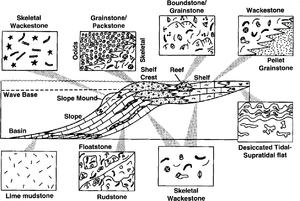Carbonate facies
| Exploring for Oil and Gas Traps | |

| |
| Series | Treatise in Petroleum Geology |
|---|---|
| Part | Predicting the occurrence of oil and gas traps |
| Chapter | Predicting reservoir system quality and performance |
| Author | Dan J. Hartmann, Edward A. Beaumont |
| Link | Web page |
| Store | AAPG Store |
Factors that control facies
An interplay of hydrologic and biologic factors produces carbonates in place. Deposition of carbonate sediments is limited to water that is warm, shallow, clear, sunlit, and free of suspended clay. When these conditions prevail, carbonates accumulate rapidly.

Basic carbonate facies zones
In general, carbonate facies develop on gently sloping shelves that can be divided into three main zones:
- A seaward zone below normal wave base
- A zone where wave energy interacts with sediment
- A landward low-energy zone
Depositional slope, geologic age, water energy, and climate control the basic facies pattern. Figure 1 shows typical carbonate facies that develop within the three zones.
Platform or ramp development
The high accumulation rates of carbonate sediments relative to subsidence generate shelf-to-basin submarine topography with a seaward face of variable steepness. As shown in the diagram in Figure 2, a platform's seaward edge steepens with time because subsidence cannot keep pace with carbonate sedimentation.
See also
- Predicting carbonate porosity and permeability
- Carbonate diagenetic stages
- Early carbonate diagenesis
- Basics of carbonate porosity formation and preservation
- Sea level cycles and carbonate sequences
- Sea level cycles and carbonate diagenesis
- Sea level cycles and climate
- Sequences during low-amplitude, high-frequency cycles
- Sequences during moderate-amplitude, high-frequency cycles
- Sequences during high-amplitude, high-frequency cycles
- Predicting carbonate reservoir location and quality
References
- ↑ Sarg, J., F., 1988, Carbonate sequence stratigraphy, in Wilgus, C., K., Hastings, B., S., Kendall, C., G. St. C., Posamentier, H., W., Ross, C., A., Van Wagoner, J., C., eds., Sea Level Changes: An Integrated Approach: SEPM Special Publication 42, p. 155–182.
